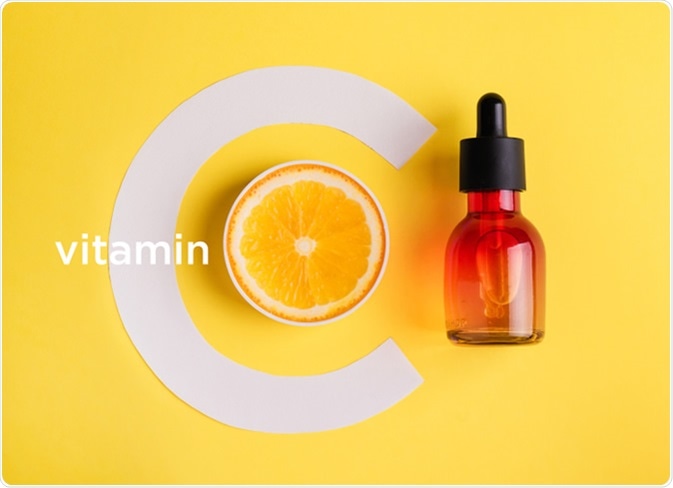Skip to:
- What is Vitamin C?
- Why do we need vitamin C?
- Vitamin C daily requirements
- Can you ever take too much vitamin C?
What is Vitamin C?
Vitamin C or ascorbic acid is a water-soluble vitamin present in fruits and vegetables. It is also available as a dietary supplement. Vitamin C is an essential dietary component – human beings are unable to produce vitamin C in their body, hence it should be included in the diet every day.

Why do we need vitamin C?
Vitamin C plays a key role in the maintenance of a healthy skin in humans. It does so by preventing the auto-inactivation of lysyl and prolyl hydroxylase – two main enzymes involved in collagen biosynthesis. Collagen also plays a vital role in wound healing.
Vitamin C is a cofactor in the biosynthesis of L- carnitine – an important molecule required for the metabolism of fatty acids. It is also required for biosynthesis of neurotransmitters such as catecholamines. The enzymatic synthesis of both carnitine and cathecholamines involves hydroxylation steps that require vitamin C for best enzyme activity.
Vitamin C also possesses powerful antioxidant properties. Vitamin C acts as a scavenger of free radicals and harmful oxygen-derived species and hence protects against oxidative stress-induced cellular damage. Many human diseases such as atherosclerosis and cancer are caused by oxidant damage to tissues; role of vitamin C in treating these disorders is being explored in various trials. The antioxidant property of vitamin C also assists in protecting against UV-induced photodamage.
Vitamin C protects the body from infections by keeping the immune system healthy. Vitamin C is also required for the absorption of nonheme iron.
Vitamin C deficiency causes a condition termed scurvy. Scurvy is characterised by fragile skin, bleeding gums, fatigue and connective tissue weakness.
Vitamin C daily requirements
The amount of vitamin C a person requires depends on the age. As per the U.S. Department of Health & Human Services, the average daily recommended amounts for different ages are as below:
| Age | Male | Female | Pregnancy | Lactation |
|---|---|---|---|---|
| 0–6 months | 40 mg | 40 mg | – | – |
| 7–12 months | 50 mg | 50 mg | – | – |
| 1–3 years | 15 mg | 15 mg | – | – |
| 4–8 years | 25 mg | 25 mg | – | – |
| 9–13 years | 45 mg | 45 mg | – | – |
| 14–18 years | 75 mg | 65 mg | 80 mg | 115 mg |
| 19+ years | 90 mg | 75 mg | 85 mg | 120 mg |
Table reproduced from an article by the Institute of Medicine, Food and Nutrition Board – Food and Nutrition Board. Dietary Reference Intakes for Vitamin C, Vitamin E, Selenium, and Carotenoidsexternal link disclaimer.
Smokers require 35 mg/day more vitamin C than non-smokers. It is believed that smoking adversely affects preferences for vitamin C rich foods; serum vitamin C levels are found to be lower in cigarette smokers than non-smokers. The poor diet of smokers is also a reason.
A healthy balanced diet can provide enough vitamin C. Fruits and vegetables are the best source of vitamin C.
Vitamin C deficiency is mainly caused by improper diet. Other risk factors for vitamin C deficiency include
- Smoking
- Pregnancy and lactation
- Low socioeconomic status
- Genetic predisposition
- Strenuous exercise
- Presence of metabolic syndromes such as hypertension, diabetes, and obesity.
Can you ever take too much vitamin C?
As vitamin C is a water-soluble vitamin, any excess is usually excreted in the urine. It is not stored in large amounts in the body. Taking too much vitamin C is unlikely to cause harmful effects; however, taking vitamin supplements in mega doses (2,000 or 3,000 mg per day) can cause diarrhea, nausea, stomach cramps, vomiting, heartburn, headache and insomnia. The stomach problems are caused by the osmotic effect of unabsorbed vitamin C in the gastrointestinal tract.
The upper limit for vitamin C in adults is 2,000 mg. Individuals with chronic liver disease, gout, or kidney disease are recommended to take no more than 1,000 mg of vitamin C per day. High vitamin C intakes have the potential to increase urinary oxalate and uric acid excretion.
Vitamin C enhances the absorption of nonheme iron; hence, vitamin C should be used with caution in individuals with hereditary hemochromatosis – a disorder characterised by abnormal accumulation of iron in the body. High doses of vitamin C could exacerbate iron overload and result in tissue damage in such individuals. Conversely, vitamin C intake is particularly important for those with low iron stores who are taking supplemental iron.
Studies have linked high intakes of vitamin C with reduced vitamin B12 and copper levels, erosion of dental enamel and allergic responses; however, these facts need further confirmation.
Sources
- U.S. Department of Health & Human Services. (2018). Vitamin C https://ods.od.nih.gov/factsheets/VitaminC-HealthProfessional/
- Boyera N, et al. (1998). Effect of vitamin C and its derivatives on collagen synthesis and cross-linking by normal human fibroblasts. Int J Cosmet Sci.;20(3):151-8. doi: 10.1046/j.1467-2494.1998.171747.x.
- Pullar, J. M., et al. (2017). The Roles of Vitamin C in Skin Health. Nutrients, 9(8), 866. doi:10.3390/nu9080866
- Padayatty SJ, et al. (2003). Vitamin C as an antioxidant: evaluation of its role in disease prevention. J Am Coll Nutr. 22(1):18-35
- Lykkesfeldt, J., et al. (2014). Vitamin C. Advances in nutrition (Bethesda, Md.), 5(1), 16–18. doi:10.3945/an.113.005157
- Schectman G, Byrd JC, Gruchow HW. The influence of smoking on vitamin C status in adults. Am J Public Health. 1989;79(2):158–162. doi:10.2105/ajph.79.2.158
Last Updated: Aug 2, 2019
Source: Read Full Article